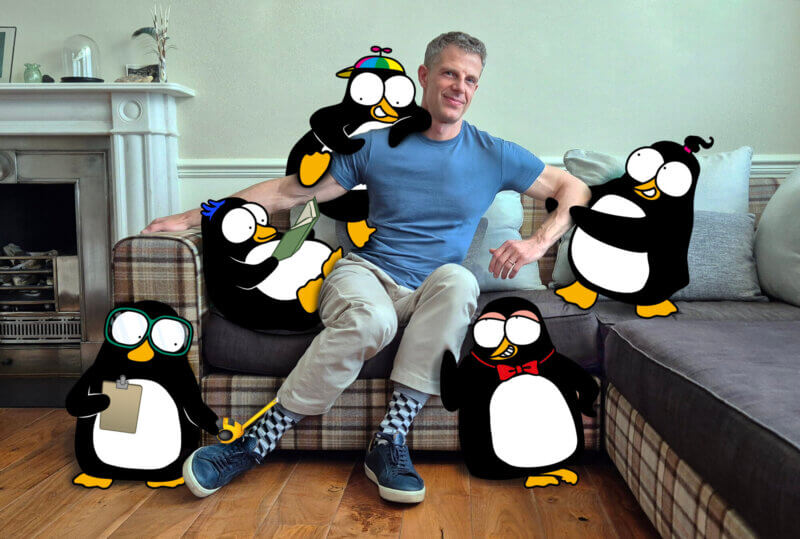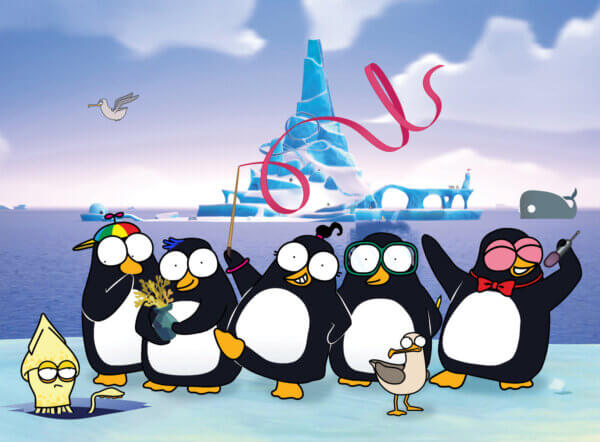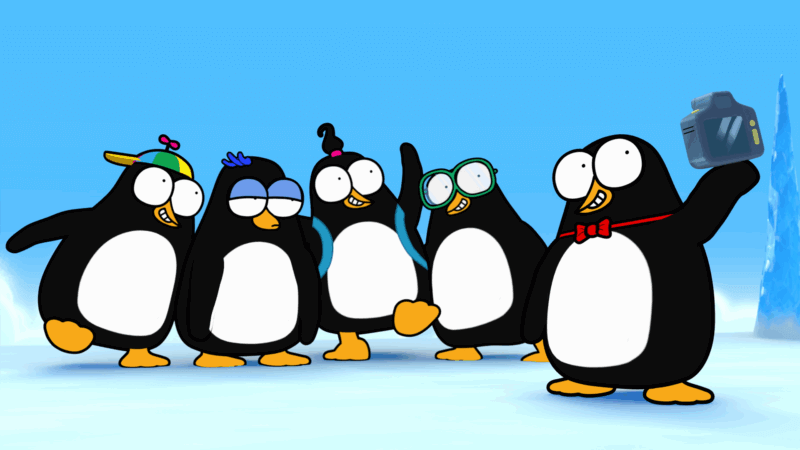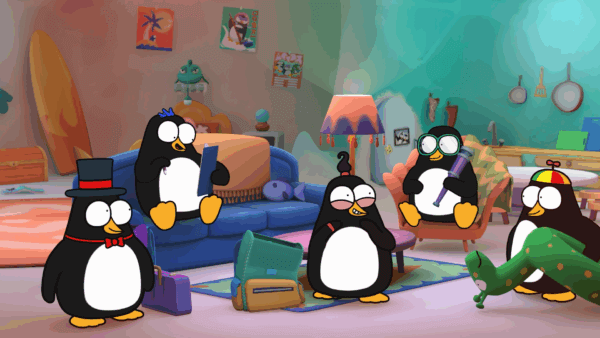Piripenguins – Interview with Series Creator Massimo Fenati

Image provided by Eaglet Films
Nearly four years have passed since I last interviewed Massimo Fenati, who was then discussing his work as the director of the Channel 4 Christmas special The Abominable Snow Baby. And in such a short space of time, he directed Quentin Blake’s Box of Treasures for the BBC, and became a co-founder of Eaglet Films alongside Tess Cuming.
But he is also the creator of his own original series, Piripenguins, which is set to be broadcasted on CBeebies on the 19th May. Set on a giant floating iceberg, the comedy show revolves around five energetic penguins who end up finding themselves in funny scenarios that they try to resolve with sometimes wacky results.
I had the opportunity to interview and catch up with Massimo during his trip to London, where he shared what creators face with developing an original IP, the challenges towards it’s approach to it’s unique blend of animations, and what it was like to have two major broadcasting commissioners to support the production.
Since we last spoke before Christmas in 2021 for our interview for The Abominable Snow Baby, you co-founded Eaglet Films with Tess Cuming in 2022. What has that new role been like for you since then?
It’s been quite exciting to run a company because it’s just a bigger project in general. You need to think about what you want to do and what is more feasible and more achievable and so you need to have short term plans and long term plans and those I find quite exciting to be honest.
And we’ve probably been quite lucky as after The Abominable Snow Baby, we got this big commission for the BBC which was Quentin Blake’s Box of Treasures, which is an anthology series adapting his books by into twenty six minute animations and on the back of that we gained quite a lot of appreciation from the BBC. It’s been a very successful series and on the back of that, I pitched the idea of Piripenguins and the BBC was very happy.
What was the inspiration behind Piripenguins and the vivid stars of the show?
It’s a very personal project for me because a long time ago, we’re talking about fifteen, sixteen years ago, I did a very simple sketch of a penguin on a post-it note that was supposed to be for somebody and I liked it so much that I was showing it saying “Oh this penguin is fantastic. We can do something with it.” Patricia Hidalgo, Director of Children and Education at the BBC, had just said in an interview that she was looking for a sitcom for children, something that could be for CBeebies but could work as a bridge show. It’s bridging between the typical preschool audience of CBeebies and the school age audience of CBBC. It could still gather all the preschoolers around the TV but with the option that the slightly older siblings that would normally not be that keen on watching preschool programmes could actually sit down and enjoy it.
It was quite an interesting challenge because it had to be the right level of speed and tone. I thought that the penguins could actually be quite a good idea and so I came up with this very simple scenario of a colony of penguins living on an iceberg that just floats around the Antarctic Ocean. And the concept for me, just because it’s for the age of children that are just about to go to school or they just started going to school, is a concept about identity because it’s the age when you suddenly leave your family home and you realise the world is not you or your siblings and your parents. There’s a lot of human beings of the same age, more or less the same height, and all of a sudden, you have to confront yourself with them and you start thinking who am I in relation to them. Am I the same? Am I different?
It’s that kind of moment when children need to work out who they are so the penguins kind of echos like the Smurfs or the Minions, where the characters are all quite similar to each other, but the personalities are very different. And so the whole concept of the show is you might look similar, but in fact, you are very unique. All of you are very different from each other and that’s beautiful. We want to celebrate that. And so the main five characters all have a sort of prop or something that kind of helps you to tell them apart, but we also pushed for very different voices, very different body language and expressions just to make them as individual and as diverse as possible. It’s become quite an interesting scenario and even for the writers at the beginning understanding characters was difficult and then after a while, it became all very easy.
In our news piece on Piripenguins last year, you mentioned “opportunities for new ideas to emerge and flourish have been shrinking steadily.” What challenges did you have as it’s creator and one of the founder of Eaglet Films to get your show off the ground?
Well, it’s interesting because at the moment, I think the industry, and in general the world of television is going through weird times because of what happened with the pandemic. All of a sudden, animation had a big influx because, obviously, live action TV couldn’t happen so there was more commissions in the animation industry and now things are coming down and of course, streamers seen a lot less money coming in because a lot of people have cancelled subscriptions. That kind of triggers the usual scenario of commissioners feeling that they would rather commission something that has a global IP, something that is already recognised and established and I understand it, but I also think at the same time it’s important to keep commissioning and green lighting completely new ideas.
We started with adapting Quentin Blake and Terry Pratchett’s works so we realised that starting from that was the way to go because as a newbie, it would have been almost impossible to pitch something completely new. You need to establish certain credentials to them to be able to say “Look, we’ve done that, but we can also do this, and give us a chance and we can prove that the new IP can be just as exciting.” it was a challenge. I think we had a very open minded sort of keen ear in the BBC.
I was very keen to select a very good team of collaborators so I was probably quite demanding when I started looking for writers, for the studios, for the talent, for the actors. But in the end, I think it paid off because the team was absolutely perfect and I’m not saying there aren’t creatives out there that are good and I just got the best, but simply that they got the best fit for the project and I think that it’s very important, somebody who really gets it and somebody who understands it and can deliver what I’m looking for. I think I got them because I’ve had the best time with the whole team honestly, starting from the writers all the way down to people working on the lightning for the final mix. So it’s been a fantastic journey for me because I enjoyed every single moment of it.
The show looks as though it has a mixture of animations in it with the characters having a two dimensional appearance in a three dimensional space. What were the decisions and challenges that you faced when blending these different animation styles?
The decision was quite simple for me, initially, because we tried to turn my very initial sketch into a 3D character, but it didn’t work. It kind of lost that immediate and very basic streamlined language that I found worked incredibly well in 2D, but I was fearing that going for a fully 2D show would have been a bit too boring because we are in a world of ice and water and there would have been a lot of white and blue. It needs the richness, it needs the extra texture and light that you can really get only from 3D so for me it was quite a no brainer to try to do the hybrid of 2D characters in a 3D world and I must say that everybody liked it from the start.
Technically, it was difficult because the penguins’ bodies are actually three dimensional although it’s rendered in a 2D element, but the face, meaning the eyes and the beaks, are in fact two dimensional so they’re actually flat. That is something quite difficult for the animators to get their heads around because basically we still need 3D animators to work on a 3D environment and a 3D body of the penguins. It’s quite a process for them and at the beginning, it was a little bit difficult, I found, especially for them, and for me, seeing that it wasn’t really working that well. But little by little, they understood how it works and now it’s actually perfectly fine.
With the show released later this month, what are you hoping that children and grown-ups will take away from it when they watch it for the first time?
The first concept I hope that would be taken will be conveyed by the programme is the one I was telling you about identity… The second one is about communal living because its also about a group of penguins stuck on an iceberg with each other and its just as much as a child being stuck in a classroom with lots of other children in that they haven’t chosen to be sitting down all day with.
Piripenguins will broadcast on CBeebies on the 19th May 2025.




